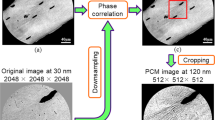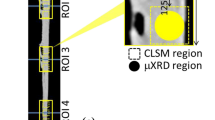Abstract
Osteocytes are the main bone cells embedded in the bone matrix where they form a large surface-area network called the lacunar-canalicular network (LCN), interconnecting their resident spaces with the lacunae by the canaliculi. Increasing evidence points toward osteocytes playing a pivotal role in maintaining bone quality. On the one hand, osteocytes transmit mechanical strain and microenvironmental signals through the LCN to regulate the activity of osteoblasts and osteoclasts; on the other hand, osteocytes are suggested to be able to remodel the LCN-associated bone matrix. However, due to the challenges involved in the assessment and characterization of the LCN-associated bone matrix, little is known about its structure and the corresponding mechanical properties. In this work, we used quantitative nanomechanical mapping, backscattered electron imaging, and nanoindentation to characterize the LCN-associated bone matrix. The results show that the techniques can be used to probe the LCN-associated bone matrix. Nanoindentation and quantitative mechanical mapping reveal spatially inhomogeneous mechanical properties of the bone matrix associated with the osteocyte lacunae and canaliculi. The obtained nano-topography and corresponding nano-mechanical maps reveal altered mechanical properties in the immediate vicinity of the osteocyte lacunae and canaliculi, which cannot be explained solely by the topographic change.

Similar content being viewed by others
References
Bonewald, L. F. The amazing osteocyte. J. Bone Miner. Res. 2011, 26, 229–238.
Teti, A.; Zallone, A. Do osteocytes contribute to bone mineral homeostasis? Osteocytic osteolysis revisited. Bon. 2009, 44, 11–16.
Vatsa, A.; Breuls, R. G.; Semeins, C. M.; Salmon, P. L.; Smit, T. H.; Klein-Nulend, J. Osteocyte morphology in fibula and calvaria—Is there a role for mechanosensing? Bon. 2008, 43, 452–458.
Dong, P.; Haupert, S.; Hesse, B.; Langer, M.; Gouttenoire, P. J.; Bousson, V.; Peyrin, F. 3D osteocyte lacunar morphometric properties and distributions in human femoral cortical bone using synchrotron radiation micro-CT images. Bon. 2014, 60, 172–185.
McCreadie, B. R.; Hollister, S. J.; Schaffler, M. B.; Goldstein, S. A. Osteocyte lacuna size and shape in women with and without osteoporotic fracture. J. Biomech. 2004, 37, 563–572.
Varga, P.; Hesse, B.; Langer, M.; Schrof, S.; Männicke, N.; Suhonen, H.; Pacureanu, A.; Pahr, D.; Peyrin, F.; Raum, K. Synchrotron X-ray phase nano-tomography-based analysis of the lacunar–canalicular network morphology and its relation to the strains experienced by osteocytes in situ as predicted by case-specific finite element analysis. Biomech. Model. Mechanobiol. 2014, 14, 267–282.
You, L. D.; Weinbaum, S.; Cowin, S. C.; Schaffler, M. B. Ultrastructure of the osteocyte process and its pericellular matrix. Anat. Rec. Part. 2004, 278A, 505–513.
Reznikov, N.; Shahar, R.; Weiner, S. Three-dimensional structure of human lamellar bone: The presence of two different materials and new insights into the hierarchical organization. Bon. 2014, 59, 93–104.
Schneider, P.; Meier, M.; Wepf, R.; Muller, R. Towards quantitative 3D imaging of the osteocyte lacuno-canalicular network. Bon. 2010, 47, 848–858.
Tang, S. Y.; Herber, R. P.; Ho, S. P.; Alliston, T. Matrix metalloproteinase–13 is required for osteocytic perilacunar remodeling and maintains bone fracture resistance. J. Bone Miner. Res. 2012, 27, 1936–1950.
Lane, N. E.; Yao, W.; Balooch, M.; Nalla, R. K.; Balooch, G.; Habelitz, S.; Kinney, J. H.; Bonewald, L. F. Glucocorticoidtreated mice have localized changes in trabecular bone material properties and osteocyte lacunar size that are not observed in placebo-treated or estrogen-deficient mice. J. Bone Miner. Res. 2006, 21, 466–476.
Klein-Nulend, J.; Bakker, A. D.; Bacabac, R. G.; Vatsa, A.; Weinbaum, S. Mechanosensation and transduction in osteocytes. Bon. 2013, 54, 182–190.
Tatsumi, S.; Ishii, K.; Amizuka, N.; Li, M. Q.; Kobayashi, T.; Kohno, K.; Ito, M.; Takeshita, S.; Ikeda, K. Targeted ablation of osteocytes induces osteoporosis with defective mechanotransduction. Cell Metab. 2007, 5, 464–475.
Price, C.; Zhou, X. Z.; Li, W.; Wang, L. Y. Real-time measurement of solute transport within the lacunar-canalicular system of mechanically loaded bone: Direct evidence for loadinduced fluid flow. J. Bone Miner. Res. 2011, 26, 277–285.
Bonewald, L. F.; Johnson, M. L. Osteocytes, mechanosensing and Wnt signaling. Bon. 2008, 42, 606–615.
Poole, K. E. S.; van Bezooijen, R. L.; Loveridge, N.; Hamersma, H.; Papapoulos, S. E.; Löwik, C. W.; Reeve, J. Sclerostin is a delayed secreted product of osteocytes that inhibits bone formation. FASEB J. 2005, 19, 1842–1844.
Busse, B.; Djonic, D.; Milovanovic, P.; Hahn, M.; Püschel, K.; Ritchie, R. O.; Djuric, M.; Amling, M. Decrease in the osteocyte lacunar density accompanied by hypermineralized lacunar occlusion reveals failure and delay of remodeling in aged human bone. Aging Cel. 2010, 9, 1065–1075.
Milovanovic, P.; Zimmermann, E. A.; Hahn, M.; Djonic, D.; Püschel, K.; Djuric, M.; Amling, M.; Busse, B. Osteocytic canalicular networks: Morphological implications for altered mechanosensitivity. ACS Nan. 2013, 7, 7542–7551.
Bélanger, L. F. Osteocytic osteolysis. Calcif. Tissue Res. 1969/70, 4, 1–12.
Qing, H.; Ardeshirpour, L.; Divieti Pajevic, P.; Dusevich, V.; Jähn, K.; Kato, S.; Wysolmerski, J.; Bonewald, L. F. Demonstration of osteocytic perilacunar/canalicular remodeling in mice during lactation. J. Bone Miner. Res. 2012, 27, 1018–1029.
Tazawa, K.; Hoshi, K.; Kawamoto, S.; Tanaka, M.; Ejiri, S.; Ozawa, H. Osteocytic osteolysis observed in rats to which parathyroid hormone was continuously administered. J. Bone Miner. Metab. 2004, 22, 524–529.
Dierolf, M.; Menzel, A.; Thibault, P.; Schneider, P.; Kewish, C. M.; Wepf, R.; Bunk, O.; Pfeiffer, F. Ptychographic X-ray computed tomography at the nanoscale. Natur. 2010, 467, 436–439.
Langer, M.; Pacureanu, A.; Suhonen, H.; Grimal, Q.; Cloetens, P.; Peyrin, F. X-Ray Phase nanotomography resolves the 3D human bone ultrastructure. PLoS On. 2012, 7, e35691.
Skedros, J. G.; Bloebaum, R. D.; Bachus, K. N.; Boyce, T. M. The meaning of graylevels in backscattered electron images of bone. J. Biomed. Mater. Res. 1993, 27, 47–56.
Sutton-Smith, P.; Beard, H.; Fazzalari, N. Quantitative backscattered electron imaging of bone in proximal femur fragility fracture and medical illness. J. Microsc. 2008, 229, 60–66.
Reznikov, N.; Almany-Magal, R.; Shahar, R.; Weiner, S. Three-dimensional imaging of collagen fibril organization in rat circumferential lamellar bone using a dual beam electron microscope reveals ordered and disordered sub-lamellar structures. Bon. 2013, 52, 676–683.
Reznikov, N.; Shahar, R.; Weiner, S. Bone hierarchical structure in three dimensions. Acta Biomater. 2014, 10, 3815–3826.
Fratzl, P.; Weinkamer, R. Nature’s hierarchical materials. Prog. Mater. Sci. 2007, 52, 1263–1334.
Weiner, S.; Wagner, H. D. The material bone: Structuremechanical function relations. Annu. Rev. Mater. Sci. 1998, 28, 271–298.
Müller, D. J.; Dufrene, Y. F. Atomic force microscopy as a multifunctional molecular toolbox in nanobiotechnology. Nat. Nanotechno. 2008, 3, 261–269.
Thompson, J. B.; Kindt, J. H.; Drake, B.; Hansma, H. G.; Morse, D. E.; Hansma, P. K. Bone indentation recovery time correlates with bond reforming time. Natur. 2001, 414, 773–776.
Fantner, G. E.; Hassenkam, T.; Kindt, J. H.; Weaver, J. C.; Birkedal, H.; Pechenik, L.; Cutroni, J. A.; Cidade, G. A. G.; Stucky, G. D.; Morse, D. E. et al. Sacrificial bonds and hidden length dissipate energy as mineralized fibrils separate during bone fracture. Nat. Mater. 2005, 4, 612–616.
Dufrene, Y. F.; Martinez-Martin, D.; Medalsy, I.; Alsteens, D.; Müller, D. J. Multiparametric imaging of biological systems by force-distance curve-based AFM. Nat. Method. 2013, 10, 847–854.
Dong, M. D.; Husale, S.; Sahin, O. Determination of protein structural flexibility by microsecond force spectroscopy. Nat. Nanotechnol. 2009, 4, 514–517.
Wegmann, S.; Medalsy, I. D.; Mandelkow, E.; Müller, D. J. The fuzzy coat of pathological human Tau fibrils is a twolayered polyelectrolyte brush. Prog. Natl. Acad. Sci. US. 2013, 110, E313–E321.
Zhang, S.; Andreasen, M.; Nielsen, J. T.; Liu, L.; Nielsen, E. H.; Song, J.; Ji, G.; Sun, F.; Skrydstrup, T.; Besenbacher, F. et al. Coexistence of ribbon and helical fibrils originating from hIAPP20–29 revealed by quantitative nanomechanical atomic force microscopy. Prog. Natl. Acad. Sci. US. 2013, 110, 2798–2803.
Adamcik, J.; Lara, C.; Usov, I.; Jeong, J. S.; Ruggeri, F. S.; Dietler, G.; Lashuel, H. A.; Hamley, I. W.; Mezzenga, R. Measurement of intrinsic properties of amyloid fibrils by the peak force QNM method. Nanoscal. 2012, 4, 4426–4429.
Medalsy, I.; Hensen, U.; Muller, D. J. Imaging and quantifying chemical and physical properties of native proteins at molecular resolution by force–volume AFM. Angew. Chem., Int. Ed. 2011, 50, 12103–12108.
Adamcik, J.; Berquand, A.; Mezzenga, R. Single-step direct measurement of amyloid fibrils stiffness by peak force quantitative nanomechanical atomic force microscopy. Appl. Phys. Lett. 2011, 98, 193701.
Thomsen, J. S.; Christensen, L.; Vegger, J.; Nyengaard, J.; Brüel, A. Loss of bone strength is dependent on skeletal site in disuse osteoporosis in rats. Calcif. Tissue Int. 2012, 90, 294–306.
Bach-Gansmo, F.; Irvine, S.; Brüel, A.; Thomsen, J.; Birkedal, H. Calcified cartilage islands in rat cortical bone. Calcif. Tissue Int. 2013, 92, 330–338.
Roschger, P.; Fratzl, P.; Eschberger, J.; Klaushofer, K. Validation of quantitative backscattered electron imaging for the measurement of mineral density distribution in human bone biopsies. Bon. 1998, 23, 319–326.
Gupta, H. S.; Stachewicz, U.; Wagermaier, W.; Roschger, P.; Wagner, H. D.; Fratzl, P. Mechanical modulation at the lamellar level in osteonal bone. J. Mater. Res. 2006, 21, 1913–1921.
Brüel, A.; Olsen, J.; Birkedal, H.; Risager, M.; Andreassen, T. T.; Raffalt, A. C.; Andersen, J. E. T.; Thomsen, J. S. Strontium ranelate is incorporated into the fracture callus, but does not influence the mechanical strength of healing rat fractures. Calcif. Tissue Int. 2011, 88, 142–152.
Oliver, W. C.; Pharr, G. M. An improved technique for determining hardness and elastic-modulus using load and displacement sensing indentation experiments. J. Mater. Res. 1992, 7, 1564–1583.
Rho, J. Y.; Tsui, T. Y.; Pharr, G. M. Elastic properties of human cortical and trabecular lamellar bone measured by nanoindentation. Biomaterial. 1997, 18, 1325–1330.
Hutter, J. L.; Bechhoefer, J. Calibration of atomic-force microscope tips. Rev. Sci. Instrum. 1993, 64, 1868–1873.
Carpentier, V. T.; Wong, J. Q.; Yeap, Y.; Gan, C.; Sutton- Smith, P.; Badiei, A.; Fazzalari, N. L.; Kuliwaba, J. S. Increased proportion of hypermineralized osteocyte lacunae in osteoporotic and osteoarthritic human trabecular bone: Implications for bone remodeling. Bon. 2012, 50, 688–694.
Seto, J.; Gupta, H. S.; Zaslansky, P.; Wagner, H. D.; Fratzl, P. Tough lessons from bone: Extreme mechanical anisotropy at the mesoscale. Adv. Funct. Mater. 2008, 18, 1905–1911.
Fratzl, P.; Gupta, H. S.; Fischer, F. D.; Kolednik, O. Hindered crack propagation in materials with periodically varying Young’s modulus—Lessons from biological materials. Adv. Mater. 2007, 19, 2657–2661.
Zhai, H. L.; Jiang, W. G.; Tao, J. H.; Lin, S. Y.; Chu, X.; Xu, X. B.; Tang, R. K. Self-assembled organic–inorganic hybrid elastic crystal via biomimetic mineralization. Adv. Mater. 2010, 22, 3729–3734.
Rho, J.-Y.; Tsui, T. Y.; Pharr, G. M. Elastic properties of human cortical and trabecular lamellar bone measured by nanoindentation. Biomaterial. 1997, 18, 1325–1330.
Cappella, B.; Dietler, G. Force-distance curves by atomic force microscopy. Surf. Sci. Rep. 1999, 34, 5–104.
Pittenger, B.; Slade, A. Performing quantitative nanomechanical AFM measurements on live cells. Microsc. Toda. 2013, 21, 12–17.
Li, Y. L.; Zhang, S.; Guo, L. J.; Dong, M. D.; Liu, B.; Mamdouh, W. Collagen coated tantalum substrate for cell proliferation. Colloids Surf. B 2012, 95, 10–15.
Gupta, H. S.; Seto, J.; Wagermaier, W.; Zaslansky, P.; Boesecke, P.; Fratzl, P. Cooperative deformation of mineral and collagen in bone at the nanoscale. Prog. Natl. Acad. Sci. US. 2006, 103, 17741–17746.
Liu, Y.; Luo, D.; Kou, X.-X.; Wang, X.-D.; Tay, F. R.; Sha, Y.-L.; Gan, Y.-H.; Zhou, Y.-H. Hierarchical intrafibrillar nanocarbonated apatite assembly improves the nanomechanics and cytocompatibility of mineralized collagen. Adv. Funct. Mater. 2012, 23, 1404–1411.
Author information
Authors and Affiliations
Corresponding authors
Electronic supplementary material
Rights and permissions
About this article
Cite this article
Zhang, S., Bach-Gansmo, F.L., Xia, D. et al. Nanostructure and mechanical properties of the osteocyte lacunar-canalicular network-associated bone matrix revealed by quantitative nanomechanical mapping. Nano Res. 8, 3250–3260 (2015). https://doi.org/10.1007/s12274-015-0825-8
Received:
Revised:
Accepted:
Published:
Issue Date:
DOI: https://doi.org/10.1007/s12274-015-0825-8




